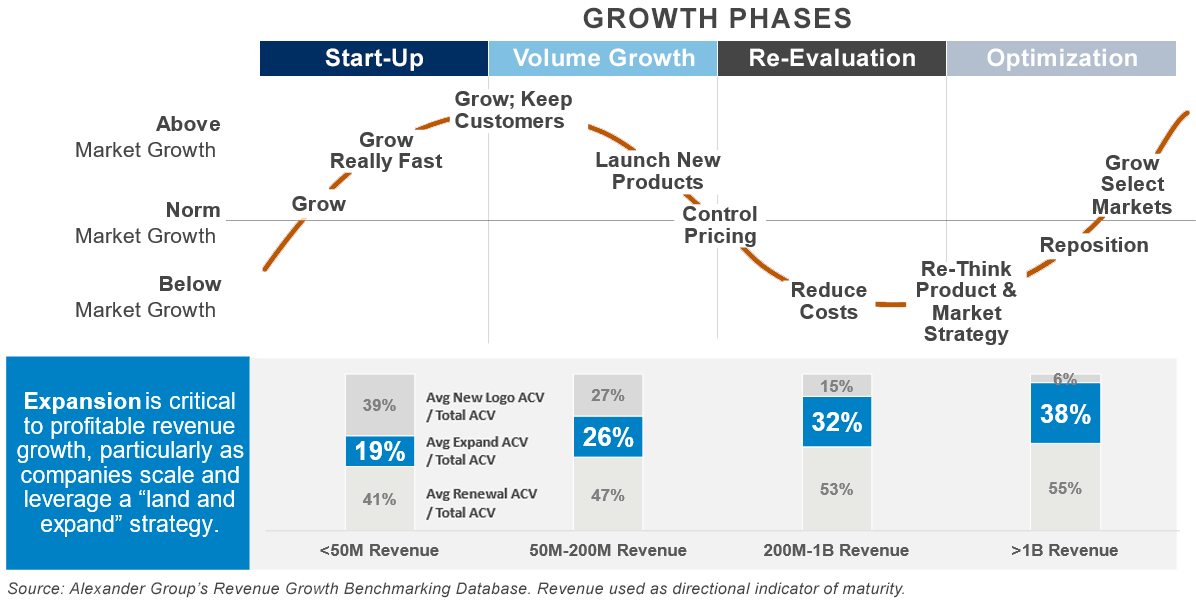Improve Account Expansion in 2024

Four New Year’s Resolutions That Will Lead to Better Account Expansion
People often make New Year’s resolutions to work on improving themselves in the upcoming year. For many technology companies, improving account expansion is a top priority in 2024. Alexander Group works with many companies to design and implement initiatives that improve commercial effectiveness, including account expansion. With that, we put together some “New Year’s resolutions” that can help your organization achieve its account expansion goals.
The technology industry knows that expansion is critical to profitable revenue growth. Most tech companies execute a “land and expand” strategy that helps them scale and increase profitability as they capture incremental annual recurring revenue (ARR) from their customer base. However, the success of this approach requires a clear strategy, efficient execution and proper incentives to maximize the productivity of the team.
Account expansion’s importance grows as a company matures—the seemingly endless supply of new logos begins to slow, and ARR growth needs to come from current customers. As described in the chart below, typically, the amount that expansion annual contract value (ACV) will contribute to a company’s overall ACV will range from 19% for less mature companies, to 38% for more mature companies. Regardless of where a company is at in its evolution, here are some resolutions that will lead to better account expansion.

Expansion Importance Varies By Company Maturity
Resolution #1: Focus on the Right Expansion Opportunities By Mastering Customer Prioritization
An XaaS software company had a large install base that was not sufficiently growing. At the core of the problem was that account managers did not know which opportunities they should prioritize, so they spent significant time pursuing smaller deals. To improve the team’s productivity, the company used data scientists to identify the firmographic attributes that signaled the expansion potential. The total addressable market (TAM) modeling did not just assess the general opportunity but looked at the propensity for a customer to buy additional products based on the products they currently purchased and the current level of spend. The output of this analysis allowed the company to reprioritize its install base according to the expansion potential and create sales plays for each type of opportunity. More importantly, it allowed the company to deprioritize the significant number of accounts with low expansion potential. These opportunities were pursued reactively, which gave the account managers more time to focus on proactively executing the expansion sales plays where they had the greatest potential for success.
Resolution #2: Enhance the Customer Experience (CX) to Create Expansion Momentum
An IT security company was struggling with poor customer experience and as a result, account expansion was challenging. The feedback from customers was clear—it was difficult to do business with the company and it was the reason that additional projects were deprioritized. To address this, the company created a comprehensive blueprint for customer experience initiatives and a dashboard of KPIs that reflected customer health. Having a documented CX vision helped the company create buy-in from commercial leaders and quarterly reporting on KPI progress ensured accountability for improvement. Additionally, the company showed customers that they listened to their feedback and addressed the pain points that they identified. This feedback loop was valued by customers and helped the company create momentum for further account expansion.
Resolution #3: Maximize Sales Success Through Timely Resource Engagement
A healthcare technology company had a healthy amount of expansion opportunities but found that its conversion rate was not at the level it expected. The company saw multiple resources supporting the expansion opportunities, but they lacked consistency as to what resources got involved in what pursuit. There were many examples of technical overlays and product specialists being pulled into upsell opportunities that should have been handled by the account manager, and highly complex cross-sell opportunities that did not have overlay support because the specialist roles did not have enough bandwidth to support the pursuit. The company decided to better define its expansion sales plays and the rules of engagement for the various sales resources in the commercial organization. As a result, the company was able to better align the sales resources to the appropriate opportunities and improve their conversion rate on the expansion pipeline.
Resolution #4: Design Better Sales Compensation Plans to Avoid Conflict Between Teams
A data management company dealt with constant conflict between its sales and renewals teams. They found that the account managers would cannibalize the current install base to cross-sell additional products. This would often result in flat ARR at the account. However, the account manager’s sales compensation plan paid them for new product ACV at a much higher rate than the renewal ACV. Additionally, the renewal rep covering the account would be negatively impacted because their compensation plan only measured renewal ACV. Because of this, the company also found that renewal reps would pursue the renewal without coordinating with the account manager. This would create conflict with expansion opportunities that the account manager was pursuing. To address this conflict, the company redesigned its compensation plan to use a growth net-churn metric in both plans. They varied plan mechanics to reflect each role’s responsibility and influence on the overall account growth. The result of the compensation change was a better-aligned commercial organization that worked together to maximize the expansion opportunity. Additionally, the plan cost modelling assured that the changes were cost-neutral relative to the previous plan.
Success in Account Expansion
Commercial organizations rely on customer expansion to drive profitable revenue growth. Successfully executing an account expansion strategy relies on several factors: focusing on the right account, ensuring a good customer experience, efficiently coordinating resources and aligning compensation.

Need help in the New Year?
For more information, please contact an Alexander Group Technology practice lead.



